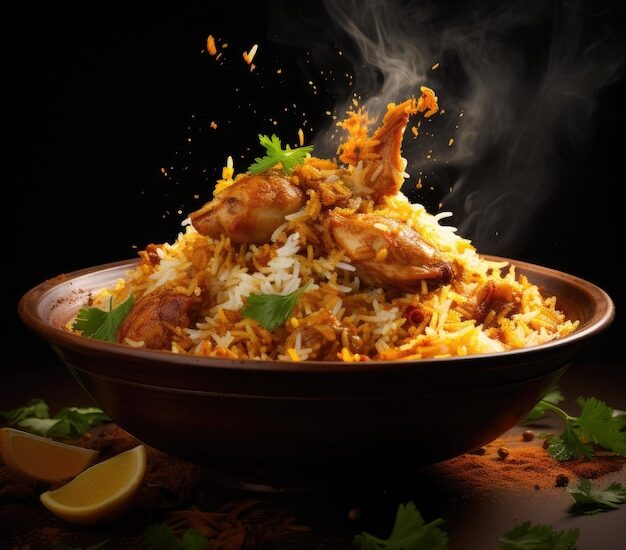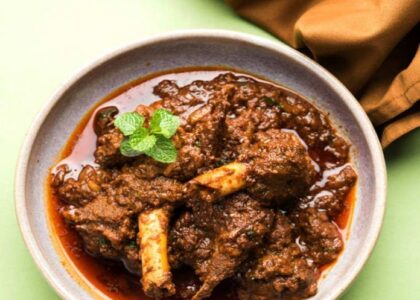Biryani, an aromatic rice dish packed with spices, tender meat (or vegetables), and rich flavors, holds a special place in the hearts of many. Originating from India, it is more than just food; it’s a symbol of celebration, tradition, and togetherness. Whether it’s a wedding feast, a family gathering, or a festival, biryani often takes center stage, uniting loved ones over a shared meal. This beloved dish’s intricate preparation and delicious aroma make it a staple for any special occasion, marking both joyous and solemn moments. Let’s dive into why biryani is not just food but a cultural experience that brings people closer.
The Festive Spirit of Biryani
Biryani has long been associated with celebrations in India. From weddings and festivals to birthdays and family reunions, this dish is an integral part of the celebratory feast. The reason lies in its rich history and cultural significance. Biryani is believed to have been introduced to India by the Mughals during their reign, though its origins are rooted in Persia. Over time, it evolved into many regional varieties, each with its own unique blend of spices and cooking techniques. But no matter the regional style, biryani has remained synonymous with festive occasions.
The dish’s elaborate preparation, which involves marinating meat (often chicken, mutton, or beef) in spices, layering it with partially cooked rice, and slow-cooking it, makes it a labor of love. Preparing biryani is a communal activity, often requiring the help of family members or friends, creating an environment of collaboration and excitement. As the layers of rice and meat come together in the pot, the anticipation builds, and the fragrance fills the home, signifying that something special is on its way.
A Symbol of Togetherness
What makes biryani even more special is the way it brings people together. Whether served at a large banquet or shared among a small family, biryani is usually enjoyed in a communal setting. The large pot or handi (traditional vessel) is often placed in the center of the table, allowing everyone to share in the feast. In Indian culture, sharing a meal is a symbol of unity and togetherness, and biryani embodies this beautifully.
Moreover, biryani is often passed down through generations, with each family adding their own personal touch. Whether it’s the choice of meat, the type of rice, or the unique blend of spices, biryani recipes are treasured and closely guarded within families. The preparation of biryani often becomes a cherished tradition—passed down from grandmother to mother, or father to son, ensuring that each family has its own version of this iconic dish.

The Different Varieties of Biryani
One of the reasons biryani is such a festive dish is because, it is incredibly versatile. While the basic concept remains the same—flavored rice cooked with meat or vegetables—the many variations across India ensure that there’s a biryani to suit every occasion and taste.
- Hyderabadi Biryani: Known for its bold spices and aromatic flavors, this biryani is often made with mutton and cooked using the Dum method (slow cooking in a sealed pot). It’s a celebratory dish, often prepared for weddings and special festivals like Eid.
- Kolkata Biryani: This variation, influenced by Persian cooking, is lighter than its Hyderabadi counterpart and typically includes boiled eggs and potatoes along with chicken or mutton. It’s rich in flavors but less spicy, making it a crowd-pleaser for all ages.
- Lucknowi (Awadhi) Biryani: A lighter, fragrant biryani made with tender meat cooked with rice, it is known for its subtle spices and delicate flavors. It’s often served during special occasions and family gatherings in Lucknow.
- Vegetarian Biryani: For those who prefer plant-based options, the vegetarian biryani is no less festive. With a variety of vegetables, paneer, and a blend of aromatic spices, it’s perfect for family feasts, especially during festivals like Diwali and Navratri.
- Sindhi Biryani: Packed with spices, yogurt, and green chilies, Sindhi Biryani is known for its vibrant and bold flavors. This version is often prepared during weddings, Eid, and other cultural celebrations in Sindh (Pakistan) and across India.
Biryani as a Cultural Experience
Biryani is not just about food; it’s an experience that binds people together. It is the centerpiece of festivals like Eid, Diwali, Onam, and weddings, and is often associated with family and community gatherings. Preparing and enjoying biryani together fosters a sense of belonging and joy.
In many households, making biryani is a family affair, where everyone—from children to grandparents—gets involved in some way. The preparation begins with washing the rice, marinating the meat, and roasting the spices. As the ingredients come together, the entire house fills with the tantalizing aroma of the biryani. The experience of waiting for the biryani to cook—sometimes for hours—is an exercise in patience and anticipation, and when it’s finally served, the first spoonful is nothing short of a celebration.
The Legacy of Biryani
The tradition of biryani continues to be passed down, especially in South Asian families, where the dish is made not just for daily meals but for grand celebrations. It’s not uncommon to find families sharing recipes, techniques, and tips across generations. These traditions keep the essence of biryani alive, ensuring that the dish remains a symbol of togetherness, love, and festivity.
Whether you are enjoying a plate of biryani at a wedding feast, a family gathering, or a festive occasion, it is the ultimate comfort food. Its rich flavors, vibrant spices, and communal nature make it a dish that transcends generations and brings families and friends together, time and time again.









